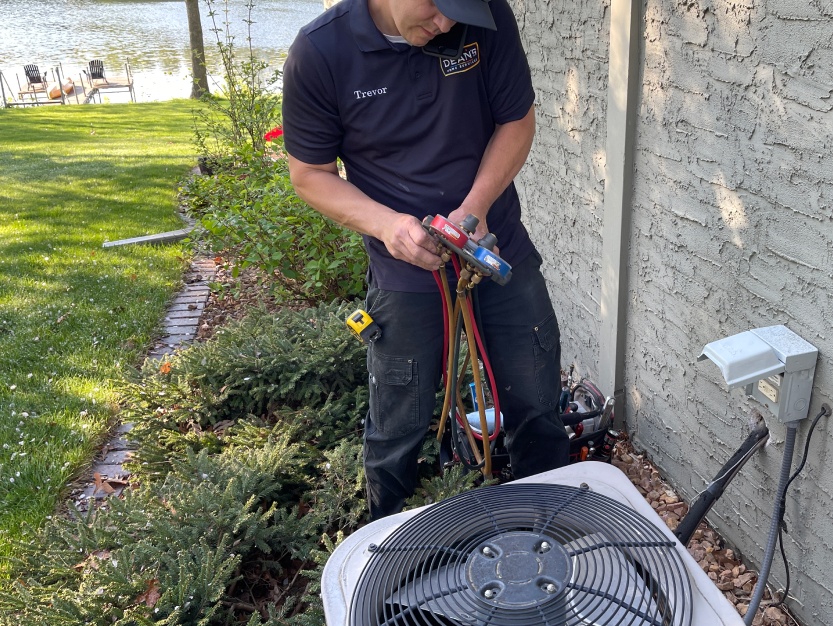Why Your Second Floor Is Always Hot (and What to Do About It)
If your second floor feels like it’s always hotter than the rest of your home, you’re not imagining things. Heat rises, but other factors at play make your upstairs rooms unbearably warm during summer. In many homes, the second floor often seems to be much hotter than the lower levels. At Dean’s Home Services in Buffalo, MN, we understand how frustrating this can be, and we’re here to help you figure out why it happens and what you can do about it.

Why Your Second Floor Is Hotter Than the Rest of the House
Many homeowners say that their second floor feels much hotter than their main floor. The main reason is simple: heat rises. As warm air moves up, it gathers on the upper floors, making them hotter, especially during the summer. This natural process can be made worse by things like poor airflow or ventilation, which keep the heat stuck upstairs.
While this can happen in any multi-story home, understanding the science behind it and identifying contributing factors like HVAC system design or insulation issues can help you bring balance to the temperature throughout your home.
Old or Poorly Designed HVAC Systems Struggle with Temperature Balance
In older homes with outdated HVAC systems, getting consistent temperatures on every floor can be a challenge. Many of these systems weren’t built to handle multi-level airflow efficiently. If your system uses a single-zone setup, the same temperature settings apply to the entire house, making it hard to cool the upper floors properly.
This issue is common in homes where the HVAC hasn’t been updated to keep up with newer technology or growing needs. If your second floor feels hot, it could be due to factors like limited ductwork or an AC unit that’s too small to handle the load.
Insulation Problems Contribute to Uneven Cooling
Another factor that plays a significant role in temperature imbalance is insulation. Proper insulation keeps your home comfortable all year long. However, in many homes, particularly older ones, you may have insufficient or deteriorating insulation in the attic or walls. Without proper insulation, warm air can escape into the second floor, making it harder for the cooling system to maintain a consistent temperature.
To help alleviate this problem, check the insulation in your attic, walls, and even around windows and doors. If your insulation is outdated, replacing it can make a substantial difference in keeping your second floor cooler.
Ductwork Issues: Blockages and Leaks
Your HVAC system relies heavily on ductwork to deliver conditioned air throughout your home. However, if your ducts are poorly designed or if there are blockages or leaks, it can cause significant problems with airflow, particularly on the second floor. Leaky ducts allow cold air to escape, reducing the efficiency of your system. Blockages or poorly placed ducts can also prevent air from reaching certain rooms, leading to uneven cooling and temperature differences between floors.
If you can see any sections of your ductwork in the attic or basement, look for damage in your ductwork. Leaky ducts not only reduce your system’s efficiency but can also drive up your energy costs. If you’re experiencing temperature imbalances, it might be time to have your ducts cleaned, sealed, or even reconfigured to improve airflow and ensure that cold air reaches the second floor effectively.
The Solution: Ductless Mini-Split Systems
If your second floor consistently gets too hot, even after addressing the issues with your HVAC system, it might be time to consider adding a ductless mini-split system. Ductless mini-splits are an excellent solution for rooms or areas in your home that aren’t getting enough cooling from your central air conditioning system. These systems don’t rely on ducts to deliver cool air, which means you don’t have to worry about leaky ducts or poor airflow.
Ductless mini-split systems are installed in individual rooms and can be controlled independently, meaning you can cool your second floor without affecting the temperature of the lower floor. These systems are highly energy-efficient and allow for precise temperature control, making them ideal for homes with temperature imbalances. Plus, they are easy to install, making them a great choice for homeowners looking to solve their cooling problems without major renovations.
Take Control of Your Home’s Temperature with a Consult
From improving airflow to upgrading your insulation or air conditioning system, there are plenty of solutions to make your home more comfortable. If you’re ready to take control of your home’s temperature, contact Dean’s Home Services today.







- Free annual evaluations
- 10% discount on repairs and equipment
- Priority scheduling
- No regular travel charges
- Discounted after-hours travel charges


